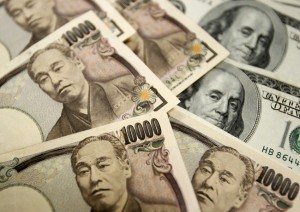 The Japanese yen advanced to the strongest level in more than a week against the US dollar as the rising tension in Ukraine and the complicated geopolitical situation on the Crimea peninsula, boosted demand for the Japanese currency as a safe-haven.
The Japanese yen advanced to the strongest level in more than a week against the US dollar as the rising tension in Ukraine and the complicated geopolitical situation on the Crimea peninsula, boosted demand for the Japanese currency as a safe-haven.
USD/JPY hit a session low at 101.73 at 10:50 GMT, after which consolidation followed at 101.78, losing 0.58% for the day. Support was likely to be received at February 17th low, 101.39, while resistance was too be encountered at February 26th high, 102.61.
The unrest in Ukraine and the subsequent order of the Russian President Vladimir Putin to put Russian troops on alert, fueled demand for haven assets including the Japanese yen.
“Stories about Russian jets have been the catalyst for the move,” said Jeremy Stretch, head of currency strategy at Canadian Imperial Bank of Commerce in London, cited by Bloomberg. “As the political temperature in Ukraine continues to heat up, then accordingly we’re seeing risk-off moves with the usual beneficiaries.”
Tension in Ukraine, especially in Crimea region, continues to rise, which yesterday forced the Russian President Vladimir Putin to order military exercises, including 150 000 troops. The troops will be located in the central and western military districts of Russia, including areas bordering Ukraine, the Interfax news agency reported. Today, Ukrainian lawmakers are expected to approve Arseniy Yatsenyuk as prime minister after three months of unrest, which ended up in last week’s ouster of the President Viktor Yanukovych.
The United States as reported by CNBC has warned Russia not to intervene militarily, because this would be a “grave mistake”.
In a Bloomberg interview, North Atlantic Treaty Organization Secretary General Anders Fogh Rasmussen said that a “sovereign, independent and stable Ukraine” is a of utmost importance for Euro-Atlantic security.
However, the yen remained under some pressure after Japan’s Ministry of Finance reported last week that the nation’s trade deficit widened to a record last month, with imports exceeding exports by 2.79 trillion yen (approximately $27.4 billion), widening the full-year trade deficit for 2013 to an unprecedented 11.5 trillion yen.
Following the report, Credit Suisse Group AG trimmed its economic growth forecast for Japan in 2014 to 1.6% from 2.2% previously.
Japan increased its import bill after the March 2011 disaster in Fukushima, made the country shut all 48 operable nuclear reactors and rely on imports of crude oil and gas. With no set date for restarting them, Japan’s import bill continues to weigh on the nation’s economy.
Volumes of energy imports have not increased significantly compared to a year ago, but their dollar value has soared amid weakening yen, which is a result of unprecedented BoJ stimulus in an attempt to snap 15 years of deflation.
A five percent increase in the volume of Japanese crude oil imports in January from a year ago, resulted in a 28% percent surge in its cost. In addition, food import costs have risen 14% in January, compared to the previous year.
Bank of Japan has been purchasing more than 7 trillion JPY (68.4 billion USD) of government bonds each month in its struggle to achieve 2% inflation in two years since April 2013.
Meanwhile, Federal Reserve Chair Janet Yellen is expected to testify in front of the Senate Banking Committee today, after the testimony was postponed on February 13th due to a snow storm. Yellen said earlier in February that US economy has gained enough strength in order to withstand reduction of monetary stimulus, while a considerable change in outlook would urge the central bank to further slow its tapering.
The Fed underscored improving economic conditions for reducing the pace of its monthly bond purchases by 10 billion USD per month in January and February. Currently the central bank buys 65 billion USD in assets each month.
Durable goods orders in the United States probably decreased 1.5% in January compared to December, according to the median estimate by experts, after a month ago orders declined 4.2%. The official numbers are scheduled to be published at 13:30 GMT. Durable goods orders represent a major part of overall factory orders in the country. Better than projected figures will certainly heighten the appeal of the US dollar.
The number of initial jobless claims, on the other hand, an indicator for lay-offs in the United States, probably dropped by 1 000 to reach 335 000 during the week ended on February 22nd.
Yesterday, the greenback was supported after official data revealed that for all of 2013, demand for US homes surged by 16.3% to reach a five-year high of 428 000.
The US Census Bureau reported that nation’s new home sales rose by 9.6% to reach annualized level of 0.468 million in January, confounding analysts’ expectations for a 1% drop to 0.400 million. At the same time, December’s reading was revised upwards to 0.427 million units from previously estimated 0.414 million units. The current housing market conditions seemed to improve as January’s reading was the strongest since June 2013, easing concerns over the US economic outlook.
Elsewhere, EUR/USD touched a session low at 1.3643 at 09:11 GMT, after which the pair consolidated at 1.3650, losing 0.26% for the day. Support was likely to be received at February 13th low, 1.3585, while resistance was to be met at February 26th high, 1.3757.





